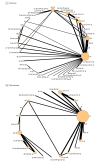Comparisons of Interventions for Preventing Falls in Older Adults: A Systematic Review and Meta-analysis
- PMID: 29114830
- PMCID: PMC5818787
- DOI: 10.1001/jama.2017.15006
Comparisons of Interventions for Preventing Falls in Older Adults: A Systematic Review and Meta-analysis
Erratum in
-
Incorrect Values in Text and Table 4.JAMA. 2021 Apr 27;325(16):1682. doi: 10.1001/jama.2020.25768. JAMA. 2021. PMID: 33904888 Free PMC article. No abstract available.
Abstract
Importance: Falls result in substantial burden for patients and health care systems, and given the aging of the population worldwide, the incidence of falls continues to rise.
Objective: To assess the potential effectiveness of interventions for preventing falls.
Data sources: MEDLINE, Embase, Cochrane Central Register of Controlled Trials, and Ageline databases from inception until April 2017. Reference lists of included studies were scanned.
Study selection: Randomized clinical trials (RCTs) of fall-prevention interventions for participants aged 65 years and older.
Data extraction and synthesis: Pairs of reviewers independently screened the studies, abstracted data, and appraised risk of bias. Pairwise meta-analysis and network meta-analysis were conducted.
Main outcomes and measures: Injurious falls and fall-related hospitalizations.
Results: A total of 283 RCTs (159 910 participants; mean age, 78.1 years; 74% women) were included after screening of 10 650 titles and abstracts and 1210 full-text articles. Network meta-analysis (including 54 RCTs, 41 596 participants, 39 interventions plus usual care) suggested that the following interventions, when compared with usual care, were associated with reductions in injurious falls: exercise (odds ratio [OR], 0.51 [95% CI, 0.33 to 0.79]; absolute risk difference [ARD], -0.67 [95% CI, -1.10 to -0.24]); combined exercise and vision assessment and treatment (OR, 0.17 [95% CI, 0.07 to 0.38]; ARD, -1.79 [95% CI, -2.63 to -0.96]); combined exercise, vision assessment and treatment, and environmental assessment and modification (OR, 0.30 [95% CI, 0.13 to 0.70]; ARD, -1.19 [95% CI, -2.04 to -0.35]); and combined clinic-level quality improvement strategies (eg, case management), multifactorial assessment and treatment (eg, comprehensive geriatric assessment), calcium supplementation, and vitamin D supplementation (OR, 0.12 [95% CI, 0.03 to 0.55]; ARD, -2.08 [95% CI, -3.56 to -0.60]). Pairwise meta-analyses for fall-related hospitalizations (2 RCTs; 516 participants) showed no significant association between combined clinic- and patient-level quality improvement strategies and multifactorial assessment and treatment relative to usual care (OR, 0.78 [95% CI, 0.33 to 1.81]).
Conclusions and relevance: Exercise alone and various combinations of interventions were associated with lower risk of injurious falls compared with usual care. Choice of fall-prevention intervention may depend on patient and caregiver values and preferences.
Conflict of interest statement
Figures




Comment in
-
Evidence Supports Action to Prevent Injurious Falls in Older Adults.JAMA. 2017 Nov 7;318(17):1659-1660. doi: 10.1001/jama.2017.15098. JAMA. 2017. PMID: 29114812 No abstract available.
-
Review: In older adults, exercise alone and some combination interventions reduce injurious falls vs usual care.Ann Intern Med. 2018 Mar 20;168(6):JC27. doi: 10.7326/ACPJC-2018-168-6-027. Ann Intern Med. 2018. PMID: 29554665 No abstract available.
-
Interventions to Prevent Falls in Older Adults.JAMA. 2018 Apr 3;319(13):1382. doi: 10.1001/jama.2018.0204. JAMA. 2018. PMID: 29614172 No abstract available.
-
Exercise interventions reduce the risk of injurious falls among older adults.Evid Based Nurs. 2018 Jul;21(3):75. doi: 10.1136/eb-2018-102917. Epub 2018 Jun 2. Evid Based Nurs. 2018. PMID: 29860238 No abstract available.
References
-
- Stel VS, Smit JH, Pluijm SM, Lips P. Consequences of falling in older men and women and risk factors for health service use and functional decline. Age Ageing. 2004;33(1):58-65. - PubMed
-
- Alamgir H, Muazzam S, Nasrullah M. Unintentional falls mortality among elderly in the United States: time for action. Injury. 2012;43(12):2065-2071. - PubMed
Publication types
MeSH terms
Substances
LinkOut - more resources
Full Text Sources
Other Literature Sources
Medical
Miscellaneous

